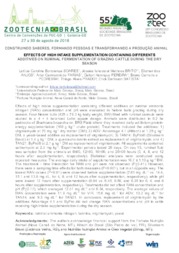Effects of high intake supplementation containing differents additives on ruminal fermentation of grazing cattle during the dry season.
Effects of high intake supplementation containing differents additives on ruminal fermentation of grazing cattle during the dry season.
Author(s): SOARES, L. C. B.; BRITO, J. I. M.; ANJOS, E. dos; FARIAS, A. C. de; PEREIRA, D. H.; PEDREIRA, B. C. e; PRADO, T. A.; BATISTA, E. D.
Summary: Effects of high intake supplementation containing different additives on ruminal ammonia nitrogen (RAN) concentration and pH were evaluated in Nelore bulls grazing during dry season. Four Nelore bulls (425 ± 79.3 kg body weight, BW) fitted with ruminal cannula were studied in a 4 × 4 balanced Latin square design. Animals were distributed in 0.2 ha paddocks of Brachiaria brizantha cv. BRS Piatã where they received daily ad libitum protein-energy supplementation (160 g kg-1 crude protein). Treatments included the additives: 1) virginiamycin at 70 mg kg-1 dry matter (DM); 2) ADV: Advantage 4.1 (Alltech) at 1.25 g kg-1 DM, a yeast-based additive as replacement of virginiamycin; 3) TAN14: ByPro® (Silvateam Brasil) at 1.4 g kg-1 DM, a quebracho tannin extract as replacement of virginiamycin; and 4) TAN21: ByPro® at 2.1 g kg-1 DM as replacement of virginiamycin. All supplements contained salinomycin at 2.5 mg kg-1. Experimental periods lasted 20 days. On day 19, ruminal fluid was sampled from the animals at 8h00, 12h00, 16h00, and 20h00 hours (0, 4, 8, and 12 hours after supplementation, respectively). Statistical analyses were conducted using repeated measures. The average daily intake of supplementation was 16.7 ± 1.19 g kg-1 BW. The treatment × time interaction for RAN and pH were not observed (P>0.41). However, there were a sampling time effects for both measures (P<0.001), but in an opposite way. The lowest RAN values (P<0.01) were observed before supplementation (7.61 mg dL-1 vs. 14.4, 15.1 and 13.0 mg dL, for 4, 8, and 12 hours after supplementation, respectively), while pH were lowest 12 hours after supplementation (6.04 vs. 6.45, 6.50, and 6.35 for 0, 4, and 8 hours after supplementation, respectively). Treatments did not affect RAN concentration and pH (P>0.17), which averaged 12.51 mg dL-1 and 6.34, respectively. The average values of RAN concentration were 11.9 mg dL-1 for VIR, 15.6 mg dL-1 for ADV, 13.2 mg dL-1 for TAN14, and 9.3 mg dL-1 for TAN21. In conclusion, replacement of virginiamycin by the additives Advantage 4.1 and ByPro did not change RAN concentrations and pH in cattle receiving high intake supplementation during the dry season.
Publication year: 2018
Types of publication: Abstract in annals or event proceedings
Keywords: Ruminal acidosis, Tannins, Virginiamycin, Yeasts
Observation
Some of Embrapa's publications are published as ePub files. To read them, use or download one of the following free software options to your computer or mobile device. Android: Google Play Books; IOS: iBooks; Windows and Linux: Calibre.
Access other publications
Access the Agricultural Research Database (BDPA) to consult Embrapa's full library collection and records.
Visit Embrapa Bookstore to purchase books and other publications sold by Embrapa.

